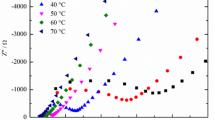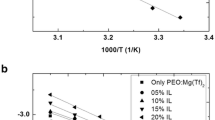Abstract
We have synthesized polyethylene oxide (PEO) + NH4PF6 polymer electrolyte films plasticized with ethylene carbonate (EC) and a mixture of ethylene carbonate and propylene carbonate (EC/PC) by using a solution cast technique. X-ray diffraction (XRD) results show a decrease in crystallinity from ∼67% in the unplasticized complex to 39% and 35% in the EC- and the EC/PC-plasticized complexes, respectively. Scanning electron microscopy (SEM) results show the formation of a fringed miscellar structure in the plasticized complexes. An increased coordination between dissociated ions and the ether oxygen of PEO on plasticization is established from the Fourier transform infrared (FTIR) studies. The ionic conductivity shows an enhancement of about two orders of magnitude on plasticization. The room-temperature ionic conductivities of the highest conducting compositions are obtained as ∼1.52 × 10−5 S cm−1 and ∼1.03 × 10−5 S cm−1 in the EC- and the EC/PC-plasticized complexes, respectively. The highest conducting compositions of plasticized polymer electrolyte films are used to fabricate proton batteries with the configuration Zn/ZnSO4.7H2O (anode) ‖Polymer electrolyte‖ PbO2/V2O5 (cathode), and different battery parameters are reported.
Similar content being viewed by others
References
B. Smitha, S. Sridhar and A. A. Khan, J. Membrane Sci. 259, 10 (2005).
A. M. M. Ali, N. S. Mohamed and A. K. Arof, J. Power Sources 74, 135 (1998).
R. Pratap, B. Singh and S. Chandra, J. Power Sources 161, 702 (2006).
L. S. Ng and A. A. Mohamad, J. Power Sources 163, 382 (2006).
M. Z. F. Kadir, S. R. Majid and A. K. Arof, Electrochim Acta 55, 1475 (2010).
H. Gao, Q. Tian and K. Lian, Solid State Ionics 181, 874 (2010).
L. Zerroual and L. Telli, Sensor Actuator B, 24, 741 (2005).
J. R. Mac Callum and C. A. Vincent, Polymer Electrolyte Review-I (Elsevier, London, 1987).
F. M. Gray, Solid Polymer Electrolytes (CVH, New York, 1991).
M. Stainer, L. C. Hardy, D. H. Whitmore and D. F. Shriver, J. Electrochem. Soc. 131, 784 (1984).
M. F. Daniel, B. Desbat and J. C. Lessegues, Solid State Ionics 28, 632 (1988).
K. K. Maurya, B. Bhattacharya and S. Chandra, Phys. Status Solidi A 47, 347 (1995).
S. A. Hashmi, A. Kumar, K. K. Maurya and S. Chandra, J. Phys. D: Appl. Phys. 23, 1307 (1990).
K. K. Maurya, S. A. Hashmi and S. Chandra, J. Phys. Soc. Jpn. 61, 1709 (1992).
P. Donoso, W. Gorecki, C. Berchier, F. Defendini, C. Poinsignon and M. B. Armand, Solid State Ionics 28, 969 (1988).
Y. Kang, J. Lee, J. Lee and C. Lee, J. Power Sources 165, 92 (2007).
Y. Kang, W. Lee, D. H. Suh and C. Lee, J. Power Sources 119, 448 (2003).
L. Fan, Z. Dang, C. W. Nan and M. Li, Electrochim. Acta 48, 205 (2002).
M. J. Reddy, J. S. Kumar, U. V. S. Rao and P. P. Chu, Solid State Ionics 177, 253 (2006).
N. Rakkapao, V. Vao-soongnern, Y. Masubuchi and H. Watanabe, Polymer 52, 2618 (2011).
G. P. Pandey, S. A. Hashmi and R. C. Agarwal, Phys. D: Appl. Phys. 41, 055409 (2008).
T. K. J. Köster and L. Wüllen, Solid State Ionics 181, 489 (2010).
S. Ibrahim, S. M. M. Yasin, N. M. Nee, R. Ahmad and R. M. Johan, Solid State Commun. 152, 426 (2012).
G. Derrien, J. Hassoun, S. Sacchetti and S. Panero, Solid State Ionics 180, 1267 (2009).
M. Kumar and S. S. Sekhon, Eur. Polym. J. 38, 1297 (2002).
X. Qian, N. Gu, Z. Cheng, X. Yang, S. Wang and S. Dong, Mater. Chem. Phys. 74, 98 (2002).
J. P. Sharma, K. Yamada and S. S. Sekhon, Macromol. Symp. 315, 188 (2012).
J. P. Sharma and S. S. Sekhon, Indian J. Eng. Mater. Sci. 12, 557 (2005).
L. R. A. K. Bandara, M. A. K. L. Dissanayake and B.-E. Mellander, Electrochim. Acta 43, 1447 (1998).
H.-J. Rhoo, H.-T. Kim, J.-K. Park and T.-S. Hwang, Electrochim. Acta 42, 1571 (1997).
S. Ramesh and A. K. Arof, Mater. Sci. Eng., B 85, 11 (2001).
Z. Yue, I. J. McEwen and J. M. G. Cowie, Solid State Ionics 156, 155 (2003).
J. Guitton, B. Dongui, R. Mosdale and M. Forestier, Solid State Ionics 28, 847 (1988).
K. Pandey, N. Lakshmi and S. Chandra, J. Power Sources 76, 116 (1998).
K. Mishra, S. A. Hashmi and D. K. Rai, Int. J. Polymer. Mater, accepted.
P. Vanysek, Electrochemical Series (CRC Press, Boca Raton, 2000).
Author information
Authors and Affiliations
Corresponding author
Rights and permissions
About this article
Cite this article
Mishra, K., Rai, D.K. Studies of a plasticized PEO + NH4PF6 proton-conducting polymer electrolyte system and its application in a proton battery. Journal of the Korean Physical Society 62, 311–319 (2013). https://doi.org/10.3938/jkps.62.311
Received:
Accepted:
Published:
Issue Date:
DOI: https://doi.org/10.3938/jkps.62.311




